By Oliver B. Pollak
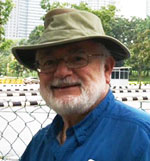
MESCHEDE, Germany — The celebration of the 100th anniversary of the founding of the Eslohe Football (soccer) club was pretext for the Goldschmidt and Bachmann family reunion in Germany. Two Goldschmidt brothers were charter organizers. Eight cousins and 13 of their spouses, children, significant others, and friends took the better part of two days to celebrate, schmooze and learn. Our family conveners Joanne and Rob were assisted by as many as ten local docents. Much beer was drunk and we came to a happy parting. Now it is time to summarize some unhappy thoughts about disruption, death and dispossession in late 1930s Deutschland.
Meschede in Sauerland is a town on the Ruhr River with 30,000 people. Jews lived in the area for several hundred years. In 1879 a few families built a two story synagogue that employed the symbol of a pentagram, a five pointed star associated with the seal of Solomon. It was a small lay-led congregation of which Pastor Wilfried Oertel has written the history. The front exterior face of the original building remains but the rest of the building is recent.
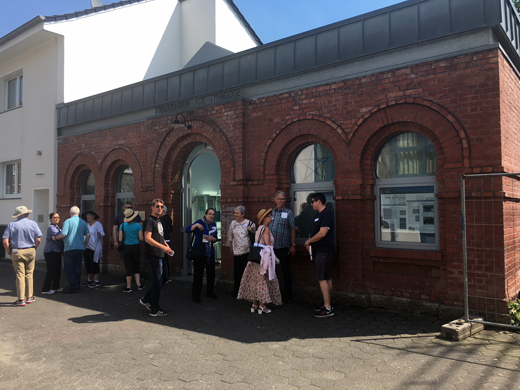
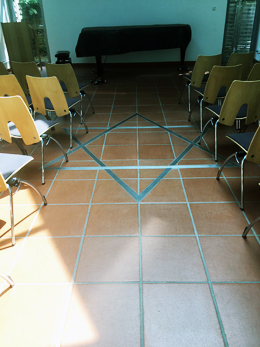
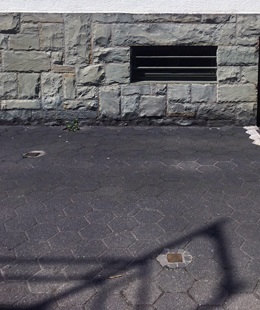
Germany’s Jews vaporized, the building was repurposed after the war, first as a carpenter’s shop and then more nobly as a community center, to serve as a remembrance of the destroyed Jewish community, and as an ecumenical cultural space complete with a grand piano. The rehabilitation, funded by government and private contribution, was completed in 1999. It has a large six pointed star in the floor. In the middle of the street opposite the former synagogue is a Stolpersteine, a Stumbling Stone, part of Europe’s almost 70,000 memorials, for Klara Arens a woman who lived across the street.
The hillside Jewish cemetery served Meschede, Eslohe and Velmede, 21km and 9 km away. It opened in 1851 and interred its last Jew in 1938. Many of the stones have been obliterated by time or human intervention. It contains at least eight Goldschmidts and two Bachmanns.
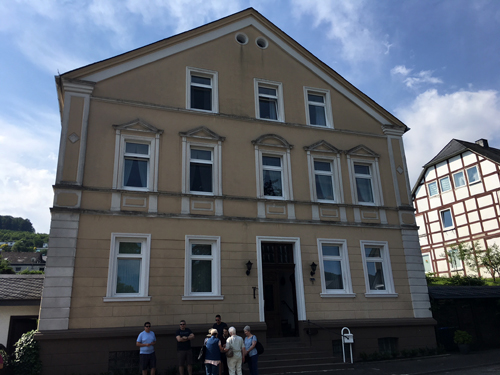
Eslohe, a town of 8,900 was the Goldschmidt home with adjacent businesses. Velmede, a town of 3,350 was the Bachmann home and also contained their business. The current owners welcomed us to their sparkling proud homes. They led us through the home and plied us with cookies and non-alcoholic fluids. Some of our group harbored varying degrees of civilized resentment and anger over transactions where their Jewish ancestors, property owners, had succumbed under duress to the sale of their homes and businesses in the late 1930s. As one cousin said, Goldschmidt and Bachmann properties sold for pfennig on the dollar, at fire sale prices.
Germans were perpetrators of two wars, 1914-1918 and 1939-1945. The villages and towns of Allies and Axis nations are peppered with memorials tucked away in cemeteries and in highly visible public places. They may list the local World War I dead sacrificed for King and Kaiser. The memorialization of 1939 to 1945 heroes, ordinary people, and villains is more problematic. In 1985 President Ronald Reagan offended many American and other nations by visiting a German military cemetery in Bitburg where many Waffen-SS were buried. But that was 33 years ago.

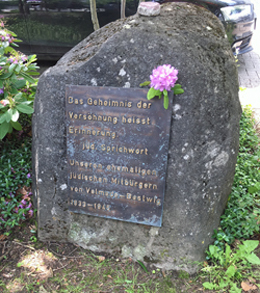
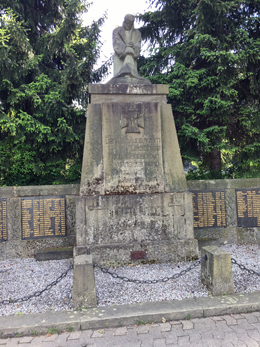
The memorials in Eslohe and Velmede have been extended to include recognition of WWII service personnel. For a visitor with emotional baggage, preserving the memory of the perpetrators is full of awkwardness. Reconciliation, getting along and forgiveness are difficult, even after almost three quarters of a century, when “never forget” is the Holocaust mantra. The size of the world’s Jewish population today is not much greater than it was 100 years ago. The loss of six million Jews was a major cause.
Memorials to Jews in Meschede lie in the former synagogue and the Stolpersteine. In Velmede there is a boulder with a plaque in what was once a small Jewish neighborhood. Eslohe does not appear to have any Holocaust memorial for Jewish victims.
Hitler, concentration camps, and murder disrupted and thinned the Jewish presence in Europe. Our band of 21 relatives contained five people from Germany, all Christians. The American contingent of 16 contained 10 Jews based on matrilineal descent, some converts, and at least four Christians. Your author was the only born Jew currently married to another Jew by birth. The Pew report on Jewish demography raises questions of Jewish survival and continuity. The cohort of 21 family and significant others contained nine Gentiles, some of whom appeared more interested in Jewish roots than the Jews themselves.
Not all the Jewish demographic diminution is due to German misdeeds. It is also the fruit of freedom of choice, the decline of religiosity, and religious matrimonial exclusiveness. Consenting adults may marry whom they want. The diversity of the inclusive big tent tends to underplay and obscure identity.
We have evolved from religion inscribed on your birth certificate marking your destiny to a more open society. Queen Elizabeth in the 16th century faced with hostility between displaced traditional Catholicism and her role as Defender of the Faith, the Anglican Church of England, said “I would not open windows into men’s souls.” Unfortunately, tolerance may reduce commitment, and also fall victim to ideologies of hatred.
.
Pollak, a professor emeritus of history at the University of Nebraska at Omaha, is a freelance writer now based in Richmond, California. He may be contacted via oliver.pollak@sdjewishworld.com
Thank you for the nice story about a reunion in Meschede, the German town in Sauerland where my father was born and lived until the Kristallnacht in november 1938.
On May 31, 2012 we had also a reunion in Meschede with family coming from Israel, the Netherlands and Germany. We arrived in order to attend a moving Stolpersteine event organised by Pastor Wilfried Oertel and a local town committee. Gunter Demnig arrived in order to put his Stolpersteine in the streets of Meschede (also for my grandparents Paula Rosenthal-Wallach en Leopold Wallach).